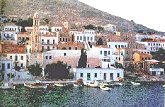| CHALKI
- Stravon calls this area "Chalchia" because
of the copper mines it possessed. Its first inhabitants were the mythic
Titans, who were succeeded by the Pelasgians. Ruins of the Pelasgian
walls can be found in the Acropolis of Chalche. The area was populated
by the Karian people and later, by the Dorians. In ancient times, the island
was divided into thirty municipalities (ktoines). The most important among
these were Chalche, two kilometres West of the Acropolis, and Phoenicia,
with its seaport, Pontamos. There were three temples, ruins of which have
survived today and bear witness to the worship of the god Apollo Helios.
In the Dodecanese, this god took the form of the Archangel Michael.
- Because the island was a municipality of Rhodes,
it followed the same course of history as Rhodes. In 315 B.C., the
people of Chalche defended the walls of Rhodes during the siege of
Dimitrios the Besieger. In 79 B.C. the island, together with Rhodes,
yielded to the Romans. During the Byzantine Era, it belonged to the
Thema, the region of the islanders. In the 7th century, it became
the victim of Arab brutality until 825, when Nikiforos Fokas released
the Dodecanese from this cruel yoke. After the abolition of the Byzantine
State by the Crusaders, Chalche passed over to the Venetians and the
Genoans until 1309, when the Johanite Knights conquered the island,
established Rhodes as their capital, and fortified all the other islands
as well. They built the fortress of Alimia and constructed their own
stronghold over the ancient Pelasgic ruins. In 1523, the island passed
to the Turks who granted them several privileges, so that they would
be administred by the Senate, which dealt with private affairs and
was responsible for the collection of the 12,000 "aspra"
tax (the Byzantine and subsequently, Turkish currency). The period
from 1835 to 1912 is characterized by the struggle of the islanders
to protect their privileges from abuse by the administration. The
ascent of the Young Turks in 1909 resulted in the massive emigration
of the inhabitants of the Dodecanese. Chalche was nearly left desolate.
The Young Turks not only abolished every kind of liberty but they
also imposed obligatory military service and the obligatory teaching
of the Turkish language in schools.
- On April 22, 1912, during the Turkish-Italian War in Tripolitida, the
Italians landed on the islands in the role of liberators and stayed there
until 1945, during which time they imposed cruel methods to try to make
the population more Italian oriented.
- Alexander Diakos was a great personality of the Second World War. His
statue stands in Liberty Square in Rhodes. Chalche joined the Greek State
on March 7, 1948 together with the other Dodecanese islands. The islanders
of Chalche were experts in navigation from ancient times and thus,
became effective sailors. In particular, their main occupation was collecting
sponges. Around 1935, they possessed a fleet of 50 fishing-boats which
brought wealth to the island.
CHALCHE OR NIMBORIO
- Built amphitheatrically around the port, with uniform two-and three-story
tile-roofed, stone houses, Chalche gives the impression of an aristocratic
town. It has been characterized as a traditional settlement and, as a result,
became an honorary Municipality. 300 inhabitants remain of the 4,000
it once had. Their main occupation is fishing, cattle-breeding and, most
recently, tourism, a constantly growing industry. The most beautiful monuments
of Chalche are the clock tower in front of the Town Hall, which can be
seen from a distance, and the Church of Saint-Nichlas with its tall bell-tower.
On the left side of the settlement, the old oil-press has been turned into
a traditional guest house. In the surrounding area, windmills stand idly
by waiting to be looked after. Today, many houses are being restored and
the island is experiencing new growth. Chalche was founded in approximately
1850-70 by the inhabitants of the Pano Horio.
by Stefanos Stefanidis
Copyright: Hellenic Electronic Center
Back to the Dodecanese Islands
|

 |

